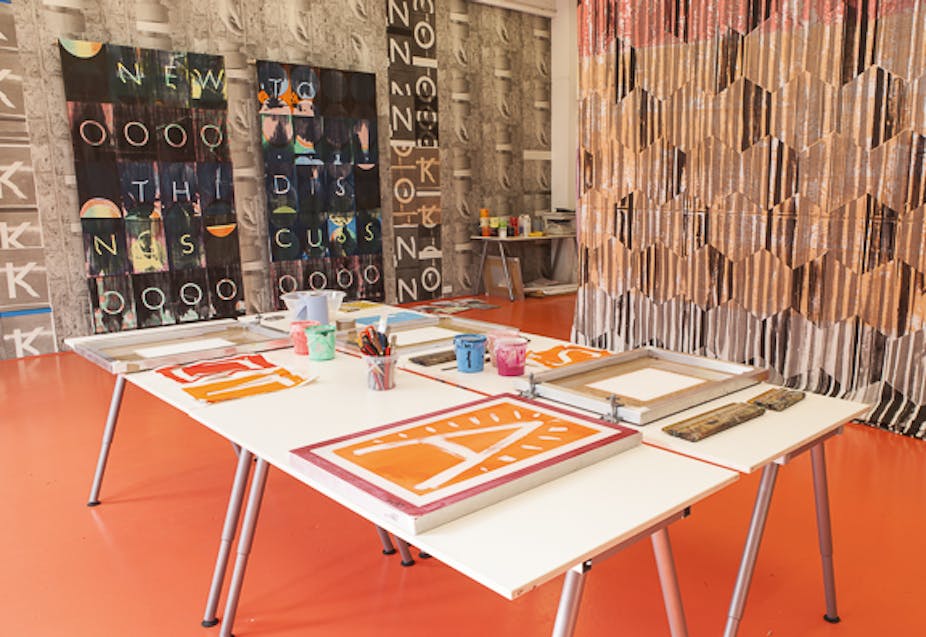In 1973, Marcel Duchamp said: “Art is not about itself, but the attention we bring to it.” This is something that this year’s Turner Prize shortlist brings to the fore. The shortlisted artists all have one thing in common – the viewer is central to the existence of the work.
The shortlist comprises Duncan Campbell, Ciara Phillips, James Richards and Tris Vonna-Michell. None of these artists is likely to be familiar to anyone outside the art world, which suggests that an emphasis has been placed on bringing artists who are not yet mainstream to greater public awareness.
Penelope Curtis, Director of the Tate Britain and chair of the judging panel, stressed this, and discussed how the artists highlight the “mobility of the contemporary art world”. She said:
The four shortlisted artists share a strong international presence and an ability to adapt, restage and reinterpret their own and others’ works, very often working in a collaborative social context.

We see this approach to reinterpretation particularly in the artists’ common use of collage. The works all “appropriate” by feeding off pre-existing works and their reference to others. Different forms of media are spliced and combined to comment and bounce off each other – archival footage and new material including a new dance work in the case of Duncan Campbell, censored artworks by Man Ray or Robert Mapplethorpe and new footage of nature in the case of James Richards.
In a formal sense collage can also elicit audience participation. It requires the viewer to come to some kind of perception or assertion as to just how or why the different fragments and mediums connect and respond to one another each time they view it. And the social or political element is often implicit in this too – whether this be the exploration of censored images in James Richards’s film, or the social function of Ciara Phillips’s workshops.
With Tris Vonna-Mitchell, shortlisted for his exhibition Postscript II (Berlin), live spoken word and a “visual script” of projections and photocopies combine. He often engages directly with his audience, asking them to contribute to the direction of his performance. Using an egg-timer and a series of photographs, a table, or the floor, Vonna-Michell foregrounds that it is in fact you, as viewers that create the work. Interested in, as he puts it, the “flexibility of meaning that exists between the image and the spoken word”, Vonna-Michell’s work is never the same twice. His performances depend on their audience, the collage that he creates includes his viewers.

Ciara Phillips’ work is a similarly flexible work in progress. She works with print in the broadest sense, producing and using textiles, screenprints, photographs and wall paintings. Her solo exhibition at The Showroom in London involved transforming the gallery into a temporary print studio where artists, designers and local women’s groups were invited in to produce new work: the exhibition, she argues, is as much about education as creation.
Many of the screenprints are made on newsprint and cotton, combining the new and the old. The exhibition explored the notion of art-making as a collaborative process and print-making itself as a democratic experience, which can have a broader socio-political impact. In this sense the work represents a move away from the artwork as a single, monumental piece into an area in which production, collaboration and creativity are prioritised.

Another common thread that runs through this year’s shortlist is an engagement with participation and, by association, the socio-political. This is not always explicit, but there are political concerns beneath the surface of all these “collages”. Curtis described the work of this year’s artists as “serious works”, contributing to a shortlist that is “perhaps less fun” than previous years, but perhaps symptomatic of our art-historic moment and the politics that surround it.
To return to Duchamp. One of his most significant contributions to modern thought was the proposition that it is the viewer who creates the work of art, rather than the artist. This year’s line up of artists likewise invite the viewer to create the work to a greater or lesser extent. It seems like a welcome move for the Turner Prize shortlist to be embracing the values of wider participation at last. The Turner Prize 2014 will open to the public on September 30.

